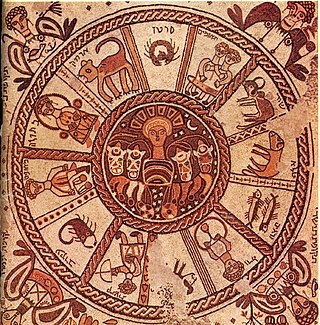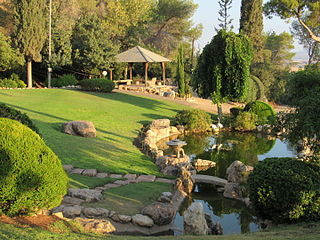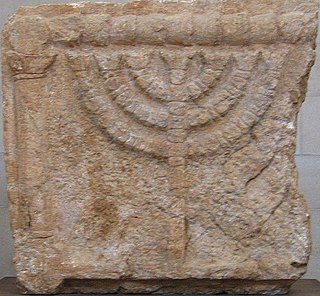
A mosaic is a pattern or image made of small regular or irregular pieces of colored stone, glass or ceramic, held in place by plaster/mortar, and covering a surface. Mosaics are often used as floor and wall decoration, and were particularly popular in the Ancient Roman world.

The Dura-Europos synagogue was an ancient Jewish former synagogue discovered in 1932 at Dura-Europos, Syria. The former synagogue contained a forecourt and house of assembly with painted walls depicting people and animals, and a Torah shrine in the western wall facing Jerusalem. It was built backing on to the city wall, which was important in its survival. The last phase of construction was dated by an Aramaic inscription to 244 CE, making it one of the oldest synagogues in the world. It was unique among the many ancient synagogues that have emerged from archaeological excavations as the structure was preserved virtually intact, and it had extensive figurative wall-paintings, which came as a considerable surprise to scholars. These paintings are now displayed in the National Museum of Damascus.

Beit Alfa is a kibbutz in the Northern District of Israel, founded in 1922 by immigrants from Poland. Located at the base of the Gilboa ridge, it falls under the jurisdiction of Gilboa Regional Council. As of 2022 its population was 1,386.

Sepphoris, known in Hebrew as Tzipori and in Arabic as Saffuriya is an archaeological site and former Palestinian village located in the central Galilee region of Israel, 6 kilometres (3.7 mi) north-northwest of Nazareth. It lies 286 meters (938 ft) above sea level and overlooks the Beit Netofa Valley. The site holds a rich and diverse historical and architectural legacy that includes remains from the Hellenistic, Roman, Byzantine, early Islamic, Crusader, Mamluk and Ottoman periods.

Astrology has been a topic of debate among Jews for over 2000 years. While not a Jewish practice or teaching as such, astrology made its way into Jewish thought, as can be seen in the many references to it in the Talmud. Astrological statements became accepted and worthy of debate and discussion by Torah scholars. Opinions varied: some rabbis rejected the validity of astrology; others accepted its validity but forbid practicing it; still others thought its practice to be meaningful and permitted. In modern times, as science has rejected the validity of astrology, many Jewish thinkers have similarly rejected it; though some continue to defend the pro-astrology views that were common among pre-modern Jews.

Jewish art, or the art of the Jewish people, encompasses a diverse range of creative endeavors, spanning from ancient Jewish art to contemporary Israeli art. Jewish art encompasses the visual plastic arts, sculpture, painting, and more, all influenced by Jewish culture, history, and religious beliefs.

The Jericho synagogue is a Jewish synagogue, located in Jericho, in the State of Palestine. The synagogue was built in the Byzantine Empire-era and is believed to date from the late 6th or early 7th century CE and was discovered in 1936. All that remains from the ancient prayer house is its mosaic floor, which contains an Aramaic inscription presenting thanks to the synagogue donors, and a well-preserved central medallion with the inscription "Shalom al Israel", meaning "Peace [up]on Israel". This led to the site also being known as Shalom Al Israel Synagogue.

Yafa an-Naseriyye is an Arab town in Israel. It forms part of the metropolitan area of Nazareth, also an Arab locality. Declared a local council in 1960, it had a population of 19,704 in 2022, approximately 70% of whom were Muslim and 30% Christian.

Heftziba is a kibbutz in northern Israel. Located on the boundaries of the Jezreel and Beit She'an Valleys between the cities of Afula and Beit She'an, it falls under the jurisdiction of Gilboa Regional Council. In 2022 it had a population of 758.

Early Byzantine mosaics in the Middle East are a group of Christian mosaics created between the 4th and the 8th centuries in ancient Syria, Palestine and Egypt when the area belonged to the Byzantine Empire. The eastern provinces of the Eastern Roman Empire and its continuation, the Byzantine Empire, inherited a strong artistic tradition from pagan Late Antiquity. The tradition of making mosaics was carried on in the Umayyad era until the end of the 8th century. The great majority of these works of art were later destroyed but archeological excavations unearthed many surviving examples.

Beth Alpha is an ancient former Jewish synagogue, located at the foot of the northern slopes of the Gilboa mountains near Beit She'an, in the Northern District of Israel. The synagogue was completed in the sixth-century CE and is now part of Bet Alfa Synagogue National Park and managed by the Israel Nature and Parks Authority.

The Gaza synagogue is a former ancient Jewish synagogue, that was built in 508 CE during the Byzantine period, Located in the ancient port city of Gaza, then known as "Maiumas", currently the Rimal district of Gaza City, in the State of Palestine, the archeological ruins of the former synagogue were discovered in 1965.

The Tzippori Synagogue, also known as the Sepphoris Synagogue, is a former ancient Jewish synagogue, now an archaeological site and a national park, that was discovered in Sepphoris, a Roman-era Jewish city in the Galilee, in northwestern Israel.

The Hand of God, or Manus Dei in Latin, also known as Dextera domini/dei, is a motif in Jewish and Christian art, especially of the Late Antique and Early Medieval periods, when depiction of Yahweh or God the Father as a full human figure was considered unacceptable. The hand, sometimes including a portion of an arm, or ending about the wrist, is used to indicate the intervention in or approval of affairs on Earth by God, and sometimes as a subject in itself. It is an artistic metaphor that is generally not intended to indicate that a hand was physically present or seen at any subject depicted. The Hand is seen appearing from above in a fairly restricted number of narrative contexts, often in a blessing gesture, but sometimes performing an action. In later Christian works it tends to be replaced by a fully realized figure of God the Father, whose depiction had become acceptable in Western Christianity, although not in Eastern Orthodox or Jewish art. Though the hand of God has traditionally been understood as a symbol for God's intervention or approval of human affairs, it is also possible that the hand of God reflects the anthropomorphic conceptions of the deity that may have persisted in late antiquity.

Ancient synagogues in Israel refers to synagogues located in Israel built by communities of Jews and Samaritans from antiquity to the Early Islamic period.

Hammath Tiberias or Hammat Tiberias is an ancient archaeological site and an Israeli national park known as Hamat Tverya National Park, which is located on the adjacent to Tiberias on the road to Zemach that runs along the shore of the Sea of Galilee.

Ancient synagogues in Palestine refers to synagogues and their remains in the Land of Israel/Palestine region, built by the Jewish and Samaritan communities from the time of the Hasmonean dynasty during the Late Hellenistic period, to the Late Byzantine period.

Huqoq or Hukkok was an ancient Jewish village, located 12.5 km north of Tiberias. The area had been settled since ancient times and is mentioned in the Book of Joshua. The Palestinian village of Yaquq later stood at Huqoq's location, and a fort named Hukok was built near the site on 11 July 1945, later followed by a kibbutz.

Synagogal Judaism or Synagogal and Sacerdotal Judaism was a branch of Judaism that emerged around the 2nd century BCE with the construction of the first synagogues in the Jewish diaspora and ancient Judea. Parallel to Rabbinic Judaism and Jewish Christianity, it developed after the destruction of the Second Temple in Jerusalem in 70 CE.

Ancient Jewish art, is art created by Jews in both the Land of Israel and in the Diaspora prior to the Middle Ages. It features symbolic or figurative motifs often influenced by biblical themes, religious symbols, and the dominant cultures of the time, including Egyptian, Hellenistic, and Roman art.
























